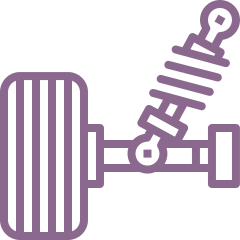Hearing regular noises coming from your car is never comforting, so hearing strut mount noises on your Toyota Iq can be distressing. This symptom may be a sign of a minor problem as well as a warning of a much larger repair to come. Whatever the case, it is crucial to check the origin and take the necessary measures to correct the problem, it is with this in mind that we wanted to produce this article to support you see more clearly. We will first check out the utility and the different types of strut mounts, then, what can be the source of a strut mount noise on your Toyota Iq, and what signs of illness this means.
The different kind of strut mount and their utility on your Toyota Iq
If you discover strut mount noise on your Toyota Iq, you must be able to determine which strut mount are involved. Their main objective is to absorb vibrations. We will now look at the different types of strut mount to support you see more clearly and find and discover them more easily.
Traditional strut mount on Toyota Iq
The most traditional strut mount is composed of two metal parts, between these two parts, is added a rubber part. The metal parts join the two components together (example: the car chassis and the engine), and the rubber part comes when it acts as a shock absorber.
strut mount anti-tilting on Toyota Iq
This form of block strut mount, generally has the shape of a rod with two elastic parts on either side of it, of each of these two blocks start from the spacers which are used to fix each of the parts to be hooked up together. When not represented in this style, it is composed of a cylinder block with a spacer in its center. The set up being encircled by a metal support, one of the two parts is hooked up by the rubber part and the other by the spacer.
Balancer strut mount on Toyota Iq
Balance type strut mount have a vertical usage, they are generally used as strut mount for the engine block. They are effective in compression and dampen the shocks and vibrations that the engine block may go through.
Hydraulic strut mount on Toyota Iq
Finally, the hydraulic strut mount is more achieved, which will not rely mainly on the use of rubber as a damping material, but on a hydraulic system filled with oil whose pressure will vary according to its use and whose control can be done digitally for the most technological.
The different symptoms and noises of strut mount on your Toyota Iq
- You encounter vibrations, loud noises of silentblocks on your Toyota Iq
- You encounter jolts when starting your Toyota Iq
- Your speeds are jumping or not going well
If you are hearing loud sounds, it is a good bet that some of the strut mount noises of your Toyota Iq are related to the end of life of one of them. It is now time to determine when the noise takes place and from which component of your car it comes. If it is loud noises when you pass over bumps or uneven roads, it may be your engine motor strut mount or stabilizer bar that are worn. If this loud sound on Toyota Iq doesn’t come from one of your strut mount, check this content page to find others answers.
If it is rather during the start that you are encoutering jerky sensations and thumping noises coming from a strut mount of your Toyota Iq. It may be your engine strut mount that are involved. In the event that the steering is not required and you start straight, it is most likely the force generated by the engine and transmission during start-up that causes the engine block to move and the worn strut mount no longer absorb these shocks. It is very easy to change them, all you need to do is use a hydraulic jack and raise the engine and change the strut mount on your Toyota Iq.
Same as above, if your gears are having trouble shifting, but you presume that your clutch is in good shape and your gearbox is not cracking specifically, you will have to reflect on replacing the engine strut mount on your Toyota Iq. Indeed, the vibrations not attenuated by them, will create a loud strut mount noise on your Toyota Iq and prevent the gears from shifting properly, and will even be able to blow them up.

